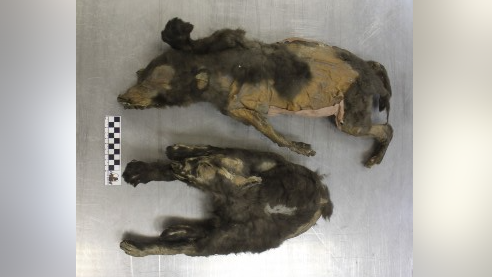Chipmunk Facts

Chipmunks are rodents that are a type of squirrel. These small, furry animals are identified by their stubby legs, bushy tails and the white, black and brown stripes that run down their backs.
Size
Chipmunks are the smallest members of the squirrel family, according to National Geographic. The biggest species of chipmunk is the Eastern chipmunk. It grows to 11 inches (28 centimeters) and weighs up to 4.4 ounces (125 grams).
Chipmunks typically grow to around 4 to 7 inches (10 to 18 cm) and weigh 1 to 5 ounces (28 to 142 g). Their tails can grow as long as 3 to 5 inches (8 to 13 cm).
Habitat
There are 25 species of chipmunk, according to National Geographic. Only one of those species, called the Siberian chipmunk, lives outside of North America. The Siberian chipmunk lives in Asia and is expanding into parts of Europe, according to the International Union for Conservation of Nature (IUCN). In North America, chipmunks can be found almost anywhere there are trees.
Chipmunks make homes for themselves by creating burrows that consist of an underground tunnel system or by making nests in logs or bushes. Their tunnel systems can be 10 to 30 feet (3 to 9.1 m) long.
Habits
Though you may see chipmunks around each other, they are not social animals. They like to keep to themselves and only interact during mating season, which is in the spring.
They are most active at dusk and dawn. Chipmunks spend most of their days foraging. A single chipmunk can gather up to 165 acorns in a day, according to National Geographic Kids.
Chipmunks hibernate, but they don't store fat to see them through long winters like bears do. During the warm months, chipmunks will stuff extra food into their cheek pouches. These cheeks are massive grocery bags. They can stretch to be three times larger than the chipmunk's head, according to Connecticut's Department of Energy and Environmental Protection. When they have a full load, they carry the food to their home and store it. During the winter, they eat from their food cache for energy.
During hibernation, chipmunks can seem like they are dead. Their heart rates can drop from 350 beats per minute to around 4 beats per minute, and their body temperature can drop from 94 degrees Fahrenheit (34.4 Celsius) to as cold as 40 F (4.44 C), according to the National Wildlife Federation (NWF).
Diet
Chipmunks are omnivores, and they aren't picky about what they eat. Part of their diet consists of vegetation such as mushrooms, berries, nuts, seeds and grains. Chipmunks also eat other creatures such as insects, baby birds, frogs and bird eggs, according to the Wildlife Hotline.
Offspring
Like other rodents, chipmunks have live births after carrying their young for a gestation period of around 30 days, according to National Geographic. Female chipmunks usually give birth to two to eight young at one time and give birth one to two times per year, once in the late spring and sometimes again in the fall. Their young are called pups. A group of pups that are born to the same mother, at the same time, is called a litter.
Pups are hairless, blind, pink creatures the size of a jelly bean. Mothers are very protective of their young and if one goes missing, she will search frantically for it, according to the Wildlife Hotline.
The protection doesn't last for long, though. Pups only stay with their parents for around two months. Then, they build their own home and start gathering food to last them throughout the coming winter.
Classification
According to the Integrated Taxonomic Information System (ITIS), the taxonomy of the chipmunk is:
- Kingdom: Animalia
- Subkingdom: Bilateria
- Infrakingdom: Deuterostomia
- Phylum: Chordata
- Subphylum: Vertebrata
- Infraphylum: Gnathostomata
- Superclass: Tetrapoda
- Class: Mammalia
- Subclass: Theria
- Infraclass: Eutheria
- Order: Rodentia
- Suborder: Sciuromorpha
- Family: Sciuridae
- Subfamily: Xerinae
- Tribe: Marmotini
- Genus: Tamias
- Subgenera: Tamias (Eastern chipmunk); Eutamias (Siberian chipmunk, with nine subspecies); Neotamias, (Western chipmunks, with 23 subspecies). Some studies have suggested that these should be separate genera.
Conservation status
According to the IUCN's Red List, only one chipmunk species is endangered. The Palmer's chipmunk, Tamias (Neotamias) palmeri, is found only on one small mountain range, the Spring Mountains in southwestern Nevada. Their population decline is due mostly to the invasion of humans in their habitat and domestic cats killing chipmunks in large numbers.
The Buller's chipmunk, Tamias (Neotamias) bulleri, is the only species listed as vulnerable. This classification is due to population decline and distribution fragmenting. The Buller's chipmunk is only found in Sierra Madre in south Durango, west Zacatecas and north Jalisco, Mexico.
Other facts
Chipmunks make various sounds to communicate. There are three recognized chipmunk calls, according to the NWF. The three calls are called the chip, the deeper chuck and the startle call. The BBC has a recording of a chipmunk's sound.
According to New Hampshire Public Television, the name "chipmunk" comes from the "chip-chip" sound the creature makes.
Chipmunks require colder temperatures to hibernate. As the temperatures warm due to global warming, they may no longer hibernate.
Additional resources
- Ohio State University: The Eastern Chipmunk (Tamias striatus) in the Home, Yard and Garden
- Animal Diversity Web (University of Michigan): Eastern Chipmunk, Least Chipmunk, Yellow-Pine Chipmunk
Sign up for the Live Science daily newsletter now
Get the world’s most fascinating discoveries delivered straight to your inbox.

